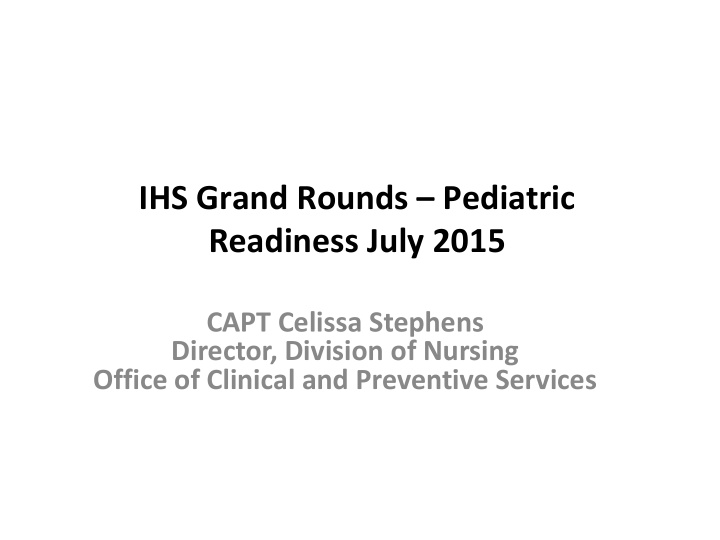



IHS Grand Rounds – Pediatric Readiness July 2015 CAPT Celissa Stephens Director, Division of Nursing Office of Clinical and Preventive Services
Purpose • National Pediatric Readiness Assessment – 100% participation by IHS and Tribal Emergency Departments • Establish a baseline of nation’s capacity to provide pediatric emergency care in the ED • Create a foundation for QI process – Includes implementation of Joint Policy Statement • Develop benchmarks to measure improvement over time
Feedback • Respondents received immediate feedback: – Readiness Score • based on 6 areas of Joint Policy Statement • Weighted scores on scale of 0-100 • Compared with similar pediatric volumes and all facilities – Gap analysis report • Individualized summary of strengths and weakness • Directed respondent to targeted components in the Pediatric Readiness Toolkit • Suggested starting point; not all inclusive
IHS/Tribal Summary Number of Hospitals Sent Assessment : 45 Number of Hospitals that Responded: 45 Response Rate: 100% 61 60 69 IHS/TRIBAL AVERAGE HOSPITAL SCORE OUT IHS/TRIBAL MEDIAN n=4,146 OF 100 SCORE OUT OF 100 NATIONAL MEDIAN SCORE
Demographics of EDs
Breakdown of Scores by Hospital Pediatric Volume Type
Guidelines for Administration and Coordination of the ED for the Care of Children
Physicians, Nurses, and Other Health Care Providers Who Staff the ED
Pediatric QI Process in ED Percentage of hospitals that responded that have a Pediatric Care Review Process= 31.8%
Guidelines for Improving Pediatric Patient Safety in the ED
Guidelines for Improving Pediatric Patient Safety in the ED continued
Guidelines for Policies, Procedures, and Protocols for the ED
Guidelines for Policies, Procedures, and Protocols for the ED
Guidelines for Equipment, Supplies, and Medication for the Care of Pediatric Patients
Next Steps • IHS and Tribal EDs are at about the same level of pediatric readiness as EDs nationally • To improve pediatric readiness – IHS continues to work with HRSA’s EMSC program – Two pilot projects • IHS is working with the State of Arizona by purchasing membership in the AZ Pediatric Prepared Emergency Care program for the 14 IHS EDs located in Arizona and New Mexico • IHS is working through the Tele-behavioral health center in Albuquerque to develop a virtual pediatric ED via telemedicine to provide access to pediatric emergency medicine specialist
Recommend
More recommend